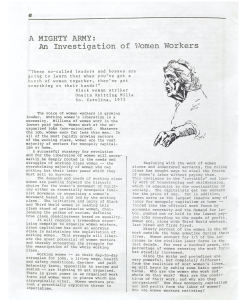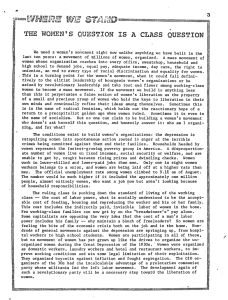Published between 1975 and 1976, WUO’s periodical Osawatomie featured book reviews, editorials, updates on the group’s progress, and even short stories. All of these contributions tackled issues central to the left including women’s issues. By focusing on two of these contributions, I aim to stress how the WUO maintained a commitment to highlighting women’s struggles and sought to bring these issues beyond nation-state borders.
“A Mighty Organization: An Investigation of Women Workers”
The periodical’s second issue featured a mass spread titled “A Mighty Army: An Investigation of Women Workers.”

The opening page of “A Mighty Army: An Investigation of Women Workers.” There is no given author for the article, rather it is a collective effort by the WUO. This article appeared in the second issue of Osawatomie, published in the Summer of 1975.
This article interrogates the working conditions of women and debunks derogatory myths about women and women’s rights. Three main questions structure the first part of the article: First, “who are the women who work for wages?” (7). Second, “Where do women workers work? (8). And third, “Why do women work?” (9). Answers to the first question introduce the reader to five key statistics about the demographic of working-class women. At the time of its publication in 1975:
40% of the workforce [were] women; Black and other Third World women are more likely to be in the work force; married women work, women who head families work, and single women work; 38% of all mothers with children under 18 work; almost half of women works are 40 years or older, almost 2/5 are 45 or older (7).

This is the second page of “A Mighty Army: An Investigation of Women Workers.” Here, the article lays out some demographics of working women including the percentage of married women who work and how many working women there are in the U.S. The three pictures below, from right to left, show a woman making shoes in Ohio, a woman digging turnips in Tennessee, and a woman washing dishes in Ohio.
Answers to the second shed light on the fact that women overwhelming work at non-unionized jobs, and about half of all women workers are “concentrated in 21 occupations which are the lowest paying jobs in the U.S.” (8). Because organizing through class solidarity was one of the main principles of the WUO, information about who comprises the working class is of paramount importance.
In response to the final question, the article essentially writes that women work for the same reasons as everyone else: survival. However, their contribution to society and economic development “has been erased from history and ridiculed by myths about womanhood, all of which serve the imperialists” (9).
The article goes on to dispel the myths that 1) “women don’t have to work;” 2) “women are hard to organize;” 3) “women belong in the home.” By dispelling these myths, the WUO positions itself as not only an explicitly feminist organization but also as one of the few organizations of the New Left that center women. Readers of Osawatomie would have largely been other members of the WUO and leftists, therefore this detailed article would hopefully work to quell sexism within the leftist community.
“The Women’s Question is a Class Question”
Each issue includes a section called “Where We Stand” meant to focus on one issue in particular and give the WUO stance. Two issues following the article “An Investigation of Women Workers”, Osawatomie’s “Where We Stand” focused on women’s liberation.

“The Women’s Question is a Class Question” statement written by Celia Sojourn, an original member of the WUO. This statement appeared in the fourth issue of Osawatomie, published in the Winter of 1975-1976.
Titled “The Women’s Question is a Class Question,” the article is written by Weatherwoman Celia Sojourn, another member of the group’s Central Committee. Echoing the group’s previous writings on the Women’s Movement and as the title states, the WUO situated women’s liberation in the larger context of class struggle. More than this though, the article goes on to talk about key problems in many mainstream feminist spaces. These issues are the separation of white women’s movement from Black and other Women of Color’s movements, the idea that men are the enemies of women, and that the women’s movement “doesn’t have to take on the state” (5). If these three issues persist, Sojourn argues, the movement will never be successful.
Works Cited
Celia Sojourn. “The Women’s Question is a Class Question.” Osawatomie, vol. 1, no. 4, Weather Underground Organization, Winter 1975-76, pp. 3-5.
Weather Underground Organization. “A Mighty Army: An Investigation of Women Workers.” Osawatomie, vol. 1, no. 2, Weather Underground Organization, Summer 1975, pp. 6-14.
